How the pandemic has changed retail and buying behaviours
June 8, 2021This article is provided by Reshift Media, a Canadian-based digital marketing and development organization specializing in retail businesses

The COVID-19 pandemic has drastically altered consumer purchasing habits, largely out of necessity but also thanks to our evolving digital media consumption. There was a 15% jump in time spent engaging with digital media between 2019 to 2020, up to a total of nearly eight hours a day, reports eMarketer. Projected to increase every year, it’s clear that digital media (and the technology that we use to consume it), will continue to play a significant role in our lives, and that consumer buying behaviour will continue to transform.
Since the pandemic began, the ways consumers engage with retailers have undergone a dramatic shift. As a result, North American retailers have had to adapt their in-store and online strategies to meet the needs of consumers.
These likely very permanent changes to retail were the focus for the first day of webinars led by the Retail Council of Canada and Reshift Media. Led by Steve Buors, Co-Founder and CEO of Reshift Media, the webinar examined how consumer purchasing and digital media consumption during the pandemic have transformed the current state of retail and what the future looks like for retailers going forward. To watch the full webinar, click here.
Changes to digital consumption
The use of mobile devices saw a large jump during the pandemic, with app usage dominating the time spent on mobile and rising to well over three-and-a-half hours a day. This is in large part due to in-app purchases that have seen a drastic increase during the pandemic, especially apps like Amazon and grocery delivery brands.
One of the primary reasons digital consumption has increased is multi-tasking. For example, a consumer’s television may be on in the background while they are scrolling through, thereby increasing time spent on their devices. While on our phones, Canadians spend an hour and forty-six minutes on social media: on average, Facebook takes up 35 of those minutes, with Twitter, Instagram, Snapchat and TikTok following closely behind.
The most significant changes relate to the behaviours linked to being at home. As indicated in the graphs below, shopping online and ordering items to pick up in store has increased, while social activities like going out to restaurants have decreased.
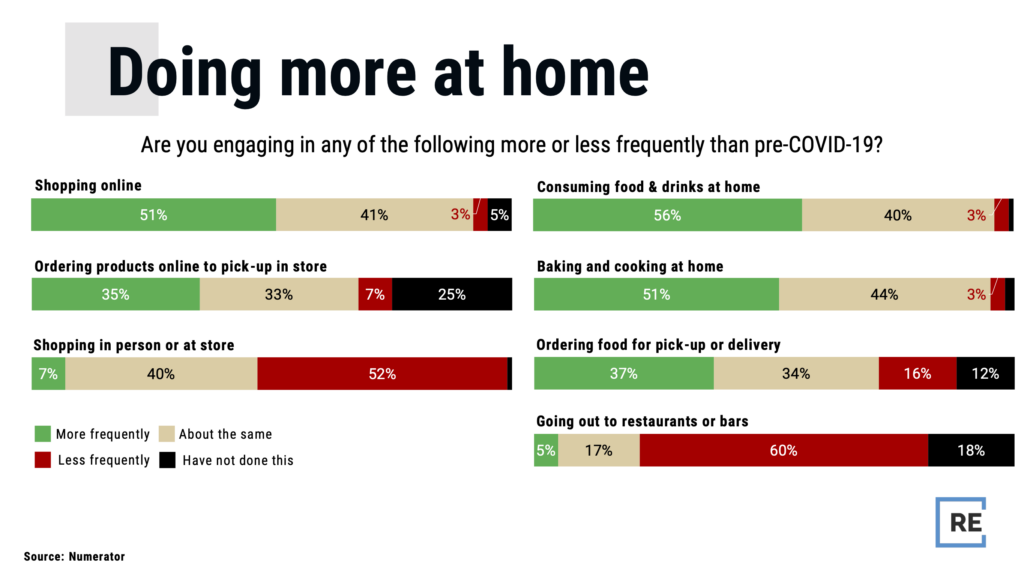
Shifts in buying behaviour
Buying habits have dramatically changed since the pandemic began. 85% of Canadians say that their shopping behaviour has been affected by COVID-19, while 50% report they are now making online purchases for typical in-store items. Most importantly, 53% of North Americans say they have changed the way they will shop going forward, indicating that the shifts that have taken place over the pandemic will have lasting impacts on retail.
Specific retail areas that have seen big shifts include online retail shopping, food ordering services, and online grocery services, all of which have seen steady increases in popularity. As well, the type of items being purchased online has also changed. According to PWC, Canadians are buying entertainment and media products online significantly more, while purchases of items such as household appliances have been put off (see graph below).
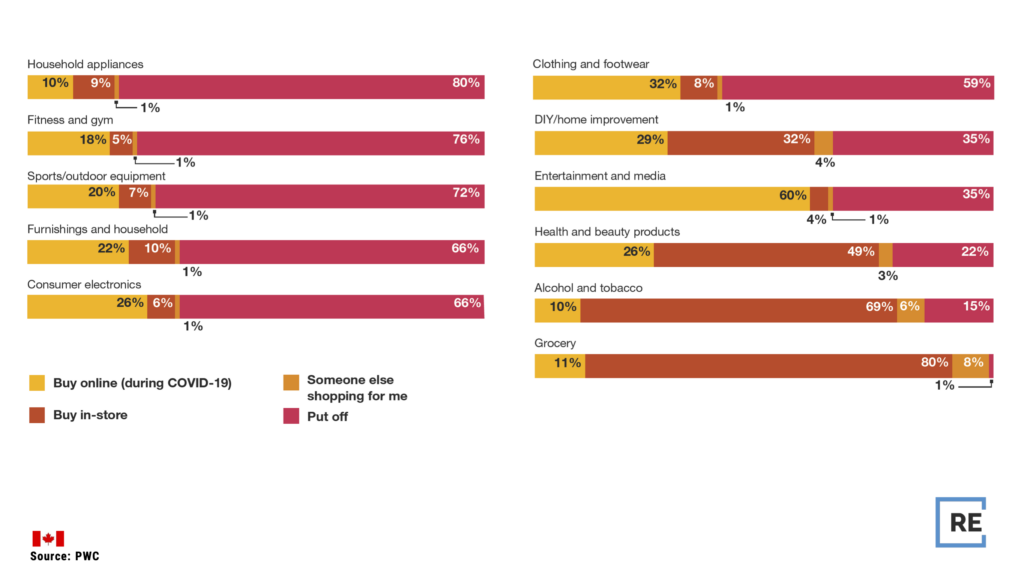
Generational differences in shopping behaviour have also been reported as a result of COVID-19. According to Prosper Insights & Analytics, boomers (1946-1964) are shopping less in store but are also the least likely to shop more online. Meanwhile, millennials (1983-1998) and Gen Xers (1965-1982) are almost tied for engaging in less in-store shopping and more online shopping. This has resulted in a 71% increase of Canadian eCommerce retail sales in 2020, equating to $37B.
Modifications to delivery
Since going into retail stores has been increasingly difficult due to fluctuating COVID-19 restrictions, the way consumers purchase and collect items has changed. Prior to the pandemic, online shopping and home delivery were common, but “click & collect” was relatively new and has seen major increases in use since the pandemic began. 30% of consumers found that this method had become a normal part of their routine in November 2020, compared to 18% just seven months prior (see graph below).
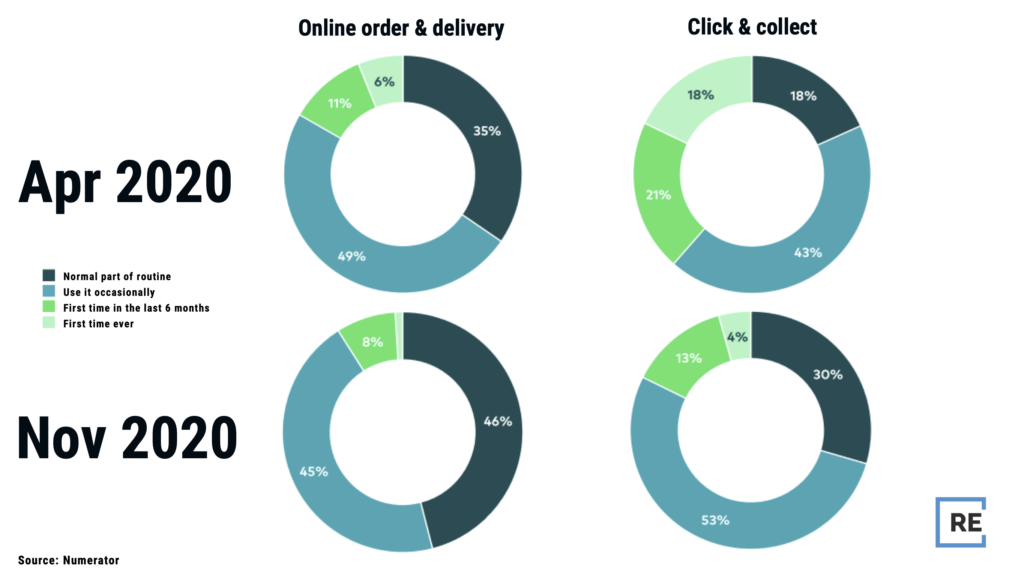
Consumers seem to have embraced “click and collect,” and are significantly more likely to use the service post-pandemic. Retailers must look at these changes to the delivery process not just as current tactics, but rather as the long-term reality.
Customer switching is more prevalent
Customer switching occurs when consumers abandon a brand/service and replace it with a competitor. This has been on the rise since the pandemic began for a variety of reasons, including because a consumer’s preferred store is out of stock of an item. In-stock availability is a major concern, particularly when it comes to online shopping. According to Numerator and Shopify, other reasons customers switch from their preferred store are: because it’s too crowded, they want to shop closer to home, they are trying to support a local business, the preferred store is closed or has limited hours, and the preferred store is too expensive.
Rapid growth for D2C companies
2020 has shown a 45% growth in Direct-to-Consumer (D2C) eCommerce sales compared to 2019, and the projected numbers are promising: 80% of consumers are expected to make a minimum of one D2C purchase in the next five years, according to eMarketer (see graph below).
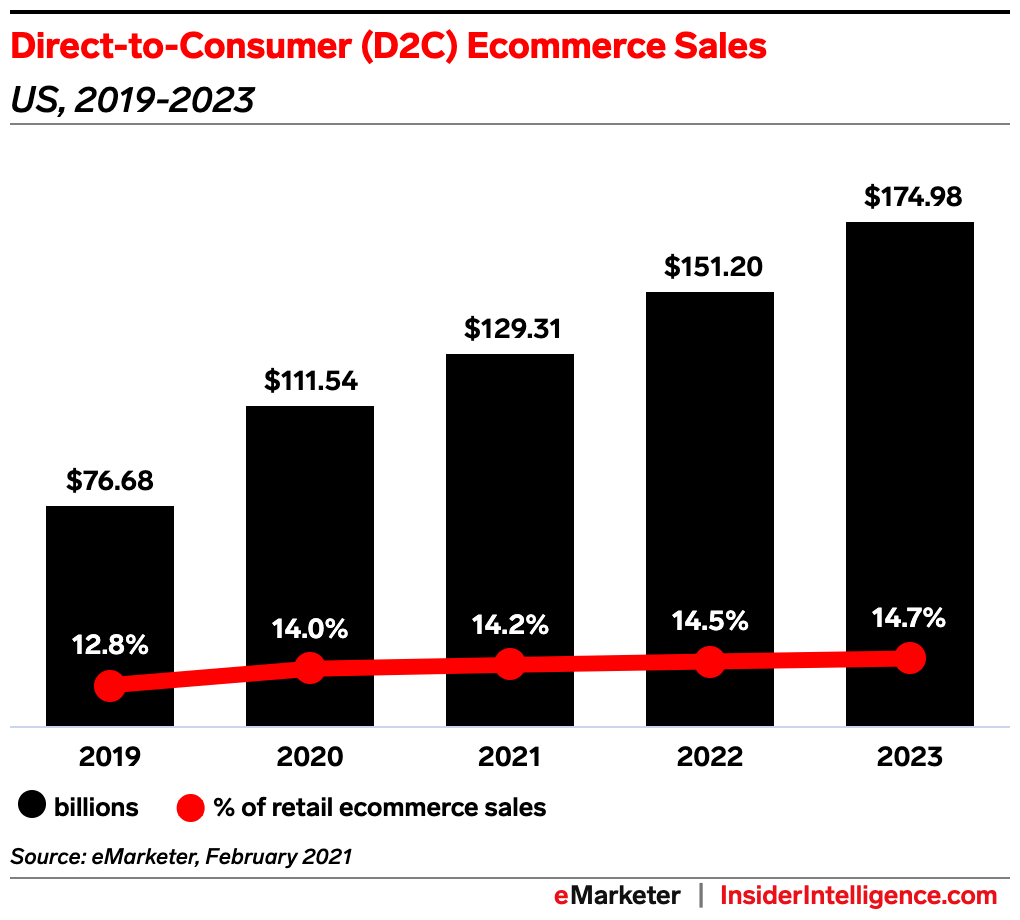
Brands that have seen growth in D2C sales include Nike with 33% total revenue, and L’Oréal, which reported a significant jump in total eCommerce sales from 16% in 2019 to 30% in 2020.
A focus on ethics and local shopping
Being environmentally friendly and following ethical practices are becoming increasingly important to consumers, with PWC reporting that 32% of Canadians are willing to pay more for brands with well known ethical practices. Similarly, 57% of buyers are seeking out local businesses to support, with 34% doing this more often than before the pandemic. The majority of consumers who fit this statistic are between 18-34 years old, but other demos follow closely behind.
There is also a greater focus on where items are being purchased since the pandemic began, which plays into the increased focus on shopping local. Products with traceable origins are a major concern among consumers and have been having an impact on purchases throughout COVID-19.
A digital-first shift in advertising
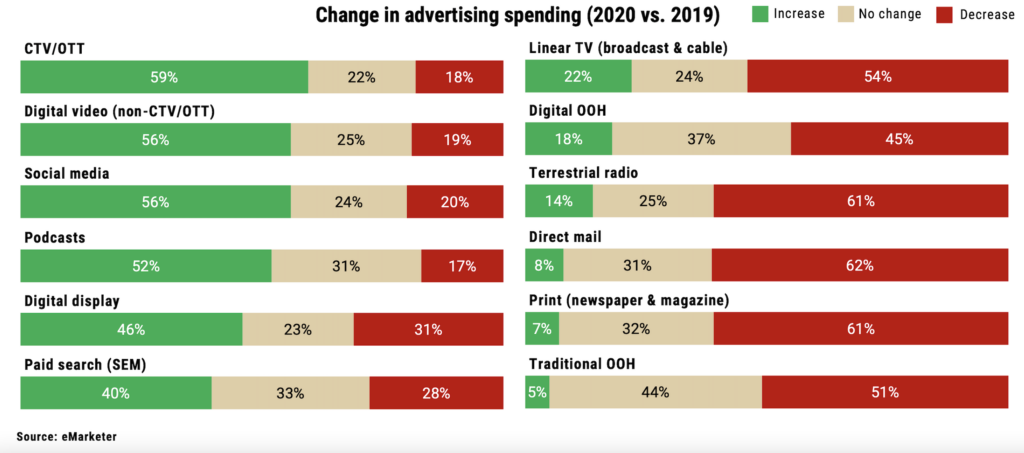
As shown in in the graphs above, advertisers have adapted to accommodate more digitally focused spending in 2020, compared to 2019. Social media, digital video, and digital display have seen major increases, mainly due to the need to reach customers where they are. Since mobile use has increased dramatically since the start of the pandemic, spending on mobile activities has taken up a large percentage of marketers’ budgets, which is set to increase even more in the next five years, according to The CMO Survey.
Although acquiring new customers has seen an increase in focus between 2020 to 2021, marketing objectives have also shifted to focus more on retaining current customers and building brand value that connects with consumers. The shift to a digital-first approach has resulted in an increase in eCommerce, mobile commerce, and social commerce projected for the next six months, according to eMarketer.
Key takeaways
COVID-19 has resulted in major changes to consumer buying habits. eCommerce has grown in popularity, while brand loyalty has decreased. Also, local and ethical buying is much more of a factor than ever before, D2C companies are growing, a focus on digital-first is much more evident in marketing budgets, and many retailers are spending more in the digital sphere in order to adapt to their customers’ shifting behaviour. Consumer habits have been significantly disrupted, which means that the way retailers operate their business has changed. Adapting quickly to these new consumer and digital trends will help set businesses up for success post-pandemic.
About Reshift Media
Reshift Media is a long-time partner of the Retail Council of Canada. The company is a Toronto-based digital marketing and development organization that provides leading-edge social media, search and website/mobile development services to retailers around the world. Please visit www.reshiftmedia.com to learn more.



